How To Plant Sunflowers Seeds (Sowing Time To Aftercare)
You can plant the sunflower seeds after the last frost is over in a well-drained, sunny location about 1-1 ½ inches deep. This blossomy brilliance needs full sun, regular watering, and nitrogen + potassium rich fertilizer to thrive.

Growing sunflowers is a rewarding and fun experience, as these bright, vibrant flowers add a splash of color to any garden. Fortunately, for novice and experienced gardeners, planting sunflowers is easy as they can thrive in various soil types.
However, knowing the precise drill can make the process more straightforward. It is where this how to grow sunflowers guide will prove beneficial.
Most people consider growing sunflowers from seeds, but it begins with picking the right location and prepping the soil. Sunflowers thrive in well-draining soil, rich in nutrients. They love the sun and desire at least six hours of direct sun every day.
Once you have decided on the location and prepped the soil, sow the seeds in the spring after the last frost about an inch deep and six inches apart.
Sunflowers usually grow tall. Hence, it is imperative to understand where and how to plant sunflower seeds to avoid overcrowding.
With regular watering, moderate fertilization, and support as they grow taller, you can easily achieve strong, tall, and beautiful blooms that brighten your garden for many weeks to follow.
Sunflower Plant information
| Scientific name | Helianthus annuus |
| Flower color | Yellow, Red, Orange |
| Hardiness zone | 2-11 |
| Soil | Well-drained, loamy |
| Watering | Regular, moderate moisture |
| Fertilizers | High in nitrogen and potassium, rather than phosphorus and potassium |
| Temperature | 70 and 78°F |
| Bloom time | 8 to 12 weeks, from early summer through late autumn |
| Height | 3–10 ft. tall, 1.5–3 ft. wide |
| Flower Lifespan | Up to two weeks |
Can You Grow Sunflowers From Sunflower Seeds?
Yes, absolutely. Sunflowers are primarily grown from seeds that you harvest from an existing sunflower in your garden or shop online or from a garden center. It will be a rewarding and fun process, resulting in attractive blooms to brighten your garden all season long.
How Do You Plant Sunflower Seeds?
Sunflowers seeds can be sown directly into the garden once the risk of frost has passed in the spring. Alternatively, you can consider starting the seeds indoors for three to four weeks before transplanting them into your garden.
Here is a detailed guide on how to do it:
Step 1 – Seed Selection
It is typically one of the most crucial steps in growing sunflowers from the seeds. Picking the right kind of seeds is vital for the success of your sunflowers. Here are some steps you must consider when choosing the seeds.
1. Seed quality: Always look for well-shaped, plump seeds that have no signs of decay or damage. Damaged or old seeds might not germinate properly or yield stunted and weak plants.
2. Seed variety: There are several different varieties of sunflowers to select from. Each specie has its own unique characteristics deciding how to plant sunflower seeds. Some cultivators are stately and tall, whereas others are bushier and short. Some sunflowers produce showy, large flowers, whereas others have several smaller flowers. Assess what you wish to achieve with the sunflowers and pick a variety that best meets your needs.
3. Seed source: Picking seeds from a reputable source is crucial. Visit a reliable supplier specializing in sunflower seeds. It shall help ensure that you pick top-quality seeds with good genetics.
4. Disease resistance: Some sunflower varieties are more resistant to common pests and diseases than others. So choose a specie with good disease resistance to reduce the risk of problems in the growing season.
Step 2 – Do you plant sunflower seeds directly in the ground?
Yes, you can grow them directly into the ground with ease. Several gardeners like to plant sunflowers straightaway in the garden as they are easy to grow from seeds.
But you must wait until the soil has warmed up and all the frost danger has passed before planting the sunflower seeds outside. It is usually in early summer or late spring.
For instance, if you reside in an area with a shorter growing season, start the seeds indoors a few weeks before the last frost date and move them outdoors after the frost danger has passed.
Step 3 – How to grow sunflower seeds in the correct location as per sunlight requirements
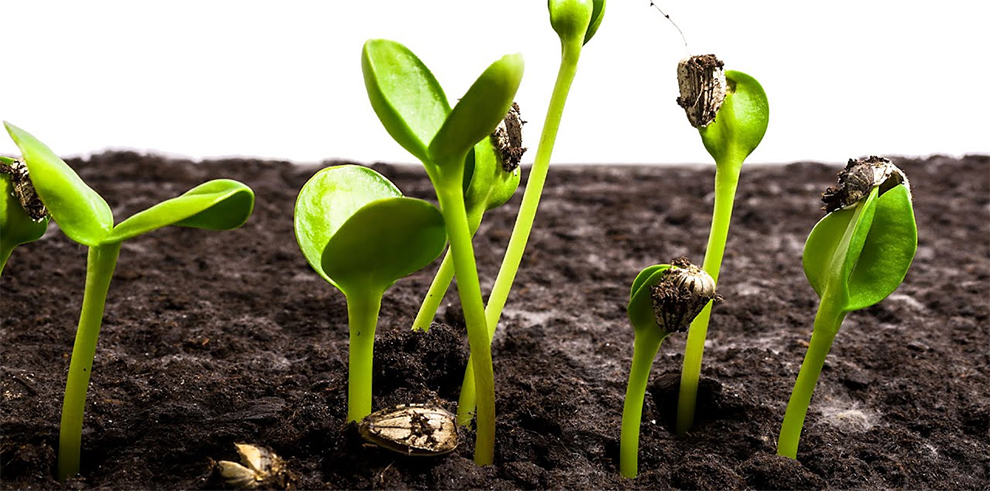
All types of Sunflowers thrive in full sun. Hence, you must select a spot that receives at least six hours of sun daily. Sunflowers are heliotropic. It means their flower heads track the sun’s movement around the day. You can help your sunflowers grow upright and straight instead of bending towards the strongest light source by ensuring ample sun exposure.
Step 4 – Prep the best soil for sunflowers
Here are the steps you must follow to prep the soil before you get to the stage to implement your learnings on how do you plant sunflower seeds.
1. Perform a soil assessment: Test the soil to determine its nutrient and pH levels. Sunflowers cherish slightly acidic soil with a pH between 6.0 and 7.5. You can buy a soil test kit from the local garden or send the soil sample to the laboratory for analysis.
2. Amend the soil: After you know the soil’s pH and nutrient levels, amend it accordingly. If the soil is too acidic, add lime to increase the pH. On the contrary, if the soil is too alkaline, add sulfur to reduce the pH. You can also add aged manure, compost, or other organic matter to better the soil’s texture and fertility.
3. Till the soil: After amending the soil, till it to a depth of about six inches. It helps distribute the amendments evenly and loosens the soil.
4. Level the soil: Take a garden hoe or rake and level the soil, and remove any debris or rocks.
Step 5 – How to sow sunflower seeds?
After the soil is ready, you can sow the sunflower seeds. Here are the steps you must follow for sowing the seeds:
A. How deep to plant sunflower seeds and spacing the sunflower seeds to prevent overcrowding
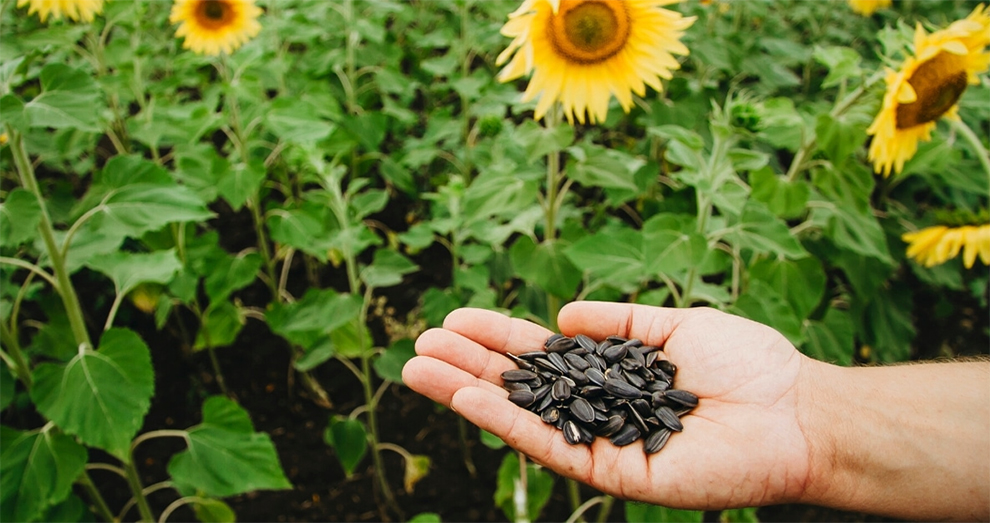
When planting sunflowers, sow the seeds at a depth of 1 to 1½ inches and space them about 6 inches apart. Do this once the soil has warmed up, usually in late spring or early spring.
You can plant multiple seeds in each location and later thin out the weaker seedlings, leaving only the strongest plants when they reach a height of six inches. It can help ensure sunflowers have enough space and resources to grow into healthy, robust plants.
B. Decide on the planting method
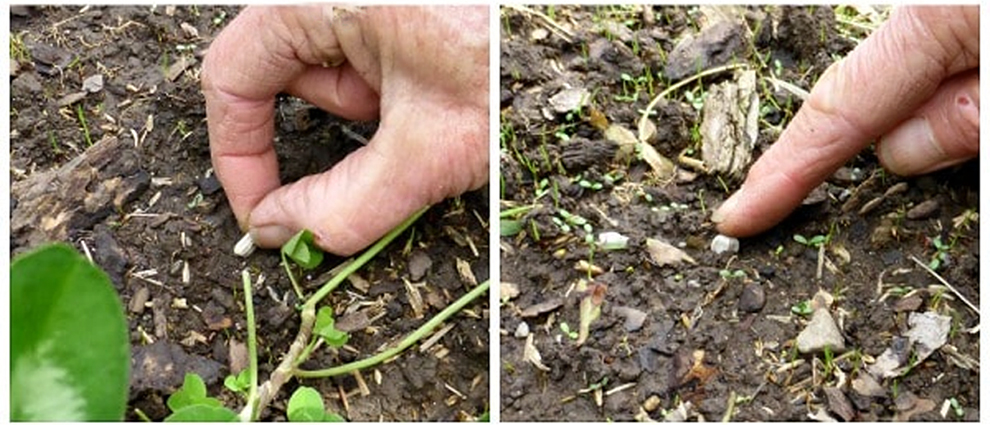
Broadly, there are two main methods of planting sunflowers – Starting seeds indoors and direct sowing.
If you know how to grow sunflower seeds directly into the soil outdoors, you can go ahead with it. It is convenient and straightforward but needs ample soil protection from birds and other animals and preparation.
Alternatively, you can start seeds indoors about three to four weeks before the last frost expected in your area.
This method gives you more control over the growing conditions and helps achieve healthier and stronger seedlings. But the method needs added equipment and space for the seedlings to grow before transplanting them outdoors.
Both these methods have their ups and downs. So, choose wisely.
C. When to plant sunflower seeds?
The best time to plant sunflowers seeds is in the late spring or early summer, once the last frost has passed and the soil has technically warmed up. The timing might vary depending on your climate and location, but ideally, it falls between mid-April to late May in the northern hemisphere.
Wait until the soil has warmed to at least 50 degrees Fahrenheit before planting, as the cooler temperatures inhibit germination and slow growth. You give your sunflowers the best chance of producing healthy blooms and thriving by growing at the right time.
Step 6 – Sunflower’s watering needs
Even though sunflowers can withstand dry conditions, regular watering is pivotal to promoting healthy blooming. It is because long periods of drought lower the flowering. Hence, allow the top one to two inches of the soil to dry before watering, as overwatering can harm the plants.
Thus, anytime you notice your sunflowers drooping or the soil drying even after doing everything right as per the how to plant sunflowers guide, it is a sign to water them. Water the soil at the plant’s base instead of spraying water onto the foliage. It helps avoid fungal diseases and conserve water.
The best time to water your sunflowers is in the morning. It gives the plant ample moisture to make it through the day.
Step 7 – Fertilizer and nutrient requirements
Typically, sunflowers are heavy feeders. They cherish nutrient-rich soil with aged manure or organic matter. You must supplement your soil with fertilizer if it is loamy. Work in a slow-release granular food eight inches deep into the soil or apply a slow-release fertilizer following the label instructions, starting in the spring.
Sunflowers need a plant food rich in potassium and nitrogen. Do not overfeed the plant, as it may make the stalks spindly.
Step 8 – Is staking needed for Sunflowers?
Sunflowers are known for their sturdy and tall stems. However, some varieties need staking to avoid falling over or bending because of heavy blooms or strong winds.
So, simply learning how to grow sunflower seeds is not enough. To ensure optimal growth of your sunflowers, you must be well-versed in sunflowers aftercare.
To stake the sunflowers, insert a metal or wood stake into the ground near the base of the plant and gently tie the stem to the stake with a soft material, such as garden tape or twine. Do it early in the plant’s growth before the stem becomes too brittle or thick.
Alternatively, you can insert a tomato cage around the sunflower and secure it to the ground with weights or stakes. It supports the stem while allowing the plant to grow through the cage. Further, adjust the cage or ties periodically to avoid them from cutting into the stem as the sunflower thickens and grows.
Step 9 – Pruning Sunflowers
Even though sunflowers do not need pruning, they can be beneficial if grown in clusters. For perennial sunflowers, prune with shears twice a year – once in summer and once in late spring. It helps maintain their shape. On the other hand, you can chop the annual sunflowers to the ground when they show signs of drying and borrowing.
Step 10 – Harvesting the Sunflower seeds
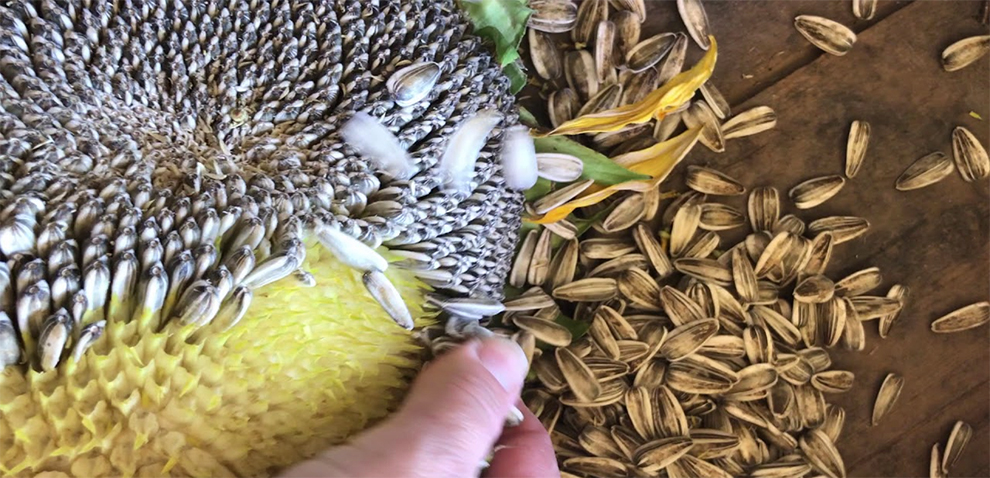
Once the sunflower petals fall off, the brown middle of the flower matures into a seed head. Now, you can harvest the seeds, eat them, or save them for next year’s garden. For harvesting, please wait until its head turns black-brown and the seeds are plump before you cut the flower head off and let it dry on or off the stem.
Usually, it takes three to four days to have the seeds ready for extraction.
Cover the flower head with cheesecloth, garden fleece, or a paper bag once the petals fall off to prevent the squirrels and birds from accessing the seeds.
While harvesting the seeds, trim the head off the plant, leaving approximately six inches of stem, and place the head in the container to catch loose seeds. Brush the hand over the seed head to knock out the seeds.
After harvesting, remove the discolored or damaged seeds and wash the leftover ones thoroughly. Let them dry before eating. However, to store them for propagation, keep them in an airtight container in a cool, dry place until the next planting.
Sunflower Pests and Diseases
Sunflowers may be susceptible to pests and diseases like beetles, rodents, birds, caterpillars, and fungal infections like rust and powdery mildew. Cover the flower head with netting to guard the seeds from pests like rodents and birds. If you notice any infestation signs, use pesticides to control pests like sunflower moths.
Further, caterpillars and beetles feed on the foliage. You can address them by apt measures. To avoid fungal infections, ensure proper air circulation around the plants and apply fungicide whenever there is an earliest sign of infection.
How To Grow Sunflowers At Home
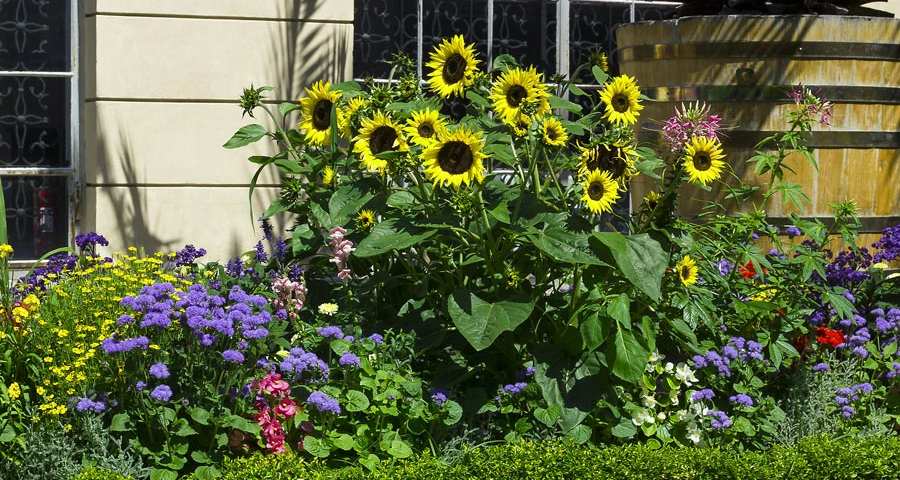
You can propagate sunflowers through cuttings, an excellent method to ensure genetic uniformity in the garden. It is easier to grow sunflowers from seeds, but if you hope to propagate with cuttings, here is what you need to do:
- Use a sharp knife or pruning shear to cut about four to six-inch stems sans buds or flowers.
- Remove the lowest leaves to expose nodes.
- Cut the top ½ inch of the cutting, sparing two terminal leaves.
- Clean the cutting’s leafless section.
- Apply a rooting hormone.
- Insert the cutting in a mix of peat moss and sand, ensuring the leafless stem section is inserted below the medium.
- Move this cutting to a warm place with light shade and cover it with a plastic bag.
- Inspect the roots after two to four weeks.
- Shift the cutting outdoors into the light shade for a week before transplanting into full sun.
You may grow sunflowers in a pot or ground, both are easy to do.
How Long Does It Take For Sunflowers To Grow?
If you know how to sow sunflower seeds, you must also realize that Sunflowers have a fast growth rate. They reach maturity within 60-90 days. But some sunflower varieties take longer – about 120 days or more, for maturity. Sunflowers have a decent lifespan and stay abloom for 2 weeks.
